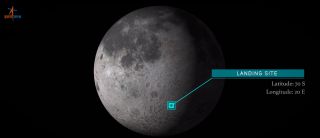India to Attempt Moon Landing at the Lunar South Pole Today. How to Watch Live – Space.com
Update for 5:28 pm ET: ISRO officials lost contact with the Vikram lander during its descent to the lunar surface. Read our full story.
India is about to land where no one has before on the moon, and you can watch it all online.
The Chandrayaan-2 lunar lander Vikram, built by the Indian Space Research Organisation (ISRO), is scheduled to land amid the craters of the moon’s south pole today (Sept. 6). Touchdown is scheduled for sometime between 4 p.m. and 5 p.m. EDT (2000-2100 GMT, 1:30 a.m. to 2:30 a.m. Sept. 7 IST). ISRO will live stream the landing in a webcast beginning at 3:40 p.m. EDT (1940 GMT, 1:10 a.m. IST).
You can watch the Indian moon landing webcast here and on Space.com’s homepage, as well as directly from the ISRO webcast here.
Video: India’s Vikram Moon Lander Explained
Related: India’s Chandrayaan-2 Mission to the Moon in Photos
Chandrayaan-2 is the second to the moon by India, following on the heels of the Chandrayaan-1 mission, but this latest project is tackling lunar exploration in more extensive fashion.Whereas Chandrayaan-1, which explored the moon from 2008 to 2009, was just an orbiter, Chandrayaan-2 has an orbiter, lander and the small rover Pragyan.
The purpose of Chandrayaan-2 is to study the mysterious moon from top to bottom, including its topography, mineralogy, exosphere, elemental abundance and even possible seismic activity. With seven instruments aboard the orbiter, three aboard the lander and a further two attached to the rover, there will be no stone left unturned.

The target landing site for India’s Chandrayaan-2 mission to explore the lunar south pole.
(Image credit: Indian Space Research Organisation)
India launched the Chandrayaan-2 mission on July 22 atop a Geosynchronous Satellite Launch Vehicle Mark III rocket from the Satish Dhawan Space Centre in Sriharikota. The mission entered orbit just under a month later, with the Chandrayaan-2 orbiter placed into orbit 62 miles (100 kilometers) above the lunar surface.
Once settled, the orbiter’s cameras, spectrometers and radars will get to work in finding the elusive lunar water ice and hydroxyl (molecules containing the oxygen and hydrogen bond) signatures. The Vikram lander, which also contains the Pragyan rover, disengaged from the orbiter on Monday (Sept. 2) to prepare for today’s landing.
The Vikram lander has a unique science payload. It contains a thermophysical experiment to measure the surface’s thermal properties, an instrument designed to study the surface’s ionosphere and atmosphere, and lastly a seismic activity instrument, which will allow scientists to delve deeper into the moon than any other instrument before. About four hours after Vikram’s (hopefully) successful landing, the Pragyan rover will be deployed from the lander, releasing the mini-tank of scientific adventure onto the lunar surface.
India’s Vikram lander and Pragyan rover are designed to last one lunar day (14 Earth days), though Chandrayaan-2 is expected to spend a full year studying the moon from above. The Chandrayaan-2 mission has a full cost of about 10 billion rupees (about $145 million), ISRO officials have said.’
Visit Space.com today for complete coverage of India’s Chandrayaan-2 Vikram landing on the moon.

(Image credit: Future)
This story was provided by How It Works Magazine, a Future PLC publication. Follow us on Twitter @Spacedotcom and on Facebook.






